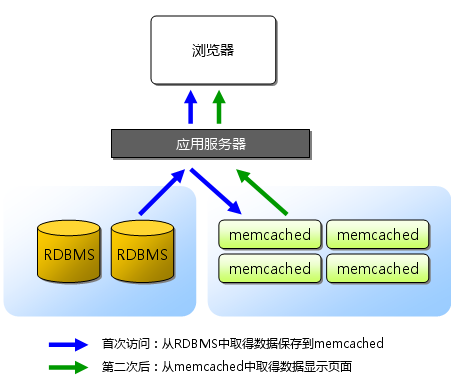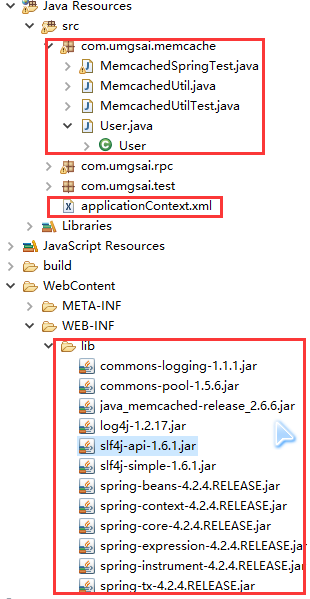Java使用memcache示例
来源:互联网 发布:tracert 路由节点优化 编辑:程序博客网 时间:2024/05/02 00:26
许多Web应用都将数据保存到RDBMS中,应用服务器从中读取数据并在浏览器中显示。 但随着数据量的增大、访问的集中,就会出现RDBMS的负担加重、数据库响应恶化、 网站显示延迟等重大影响。
这时就该memcached大显身手了。memcached是高性能的分布式内存缓存服务器。 一般的使用目的是,通过缓存数据库查询结果,减少数据库访问次数,以提高动态Web应用的速度、 提高可扩展性。

Windows系统下memcache的安装
cmd进入到memcache目录下(win10需要以管理员身份运行cmd)

memcache.exe -d install
memcache.exe -d start
启动memcache服务后可以在windows服务中看到名称为memcache 的服务
Java使用memcache
项目目录如下

User.java
public class User implements Serializable{ private static final long serialVersionUID = 1L; private String username; private String password; //省略构造函数级getter setter @Override public int hashCode() { final int prime = 31; int result = 1; result = prime * result + ((password == null) ? 0 : password.hashCode()); result = prime * result + ((username == null) ? 0 : username.hashCode()); return result; } @Override public boolean equals(Object obj) { if (this == obj) return true; if (obj == null) return false; if (getClass() != obj.getClass()) return false; User other = (User) obj; if (password == null) { if (other.password != null) return false; } else if (!password.equals(other.password)) return false; if (username == null) { if (other.username != null) return false; } else if (!username.equals(other.username)) return false; return true; }}MemcachedUtil.java
public class MemcachedUtil { /** * memcached客户端单例 */ private static MemCachedClient cachedClient = new MemCachedClient(); /** * 初始化连接池 */ static { //获取连接池的实例 SockIOPool pool = SockIOPool.getInstance(); //服务器列表及其权重 String[] servers = {"127.0.0.1:11211"}; Integer[] weights = {3}; //设置服务器信息 pool.setServers(servers); pool.setWeights(weights); //设置初始连接数、最小连接数、最大连接数、最大处理时间 pool.setInitConn(10); pool.setMinConn(10); pool.setMaxConn(1000); pool.setMaxIdle(1000*60*60); //设置连接池守护线程的睡眠时间 pool.setMaintSleep(60); //设置TCP参数,连接超时 pool.setNagle(false); pool.setSocketTO(60); pool.setSocketConnectTO(0); //初始化并启动连接池 pool.initialize(); //压缩设置,超过指定大小的都压缩// cachedClient.setCompressEnable(true);// cachedClient.setCompressThreshold(1024*1024); } private MemcachedUtil(){ } public static boolean add(String key, Object value) { return cachedClient.add(key, value); } public static boolean add(String key, Object value, Integer expire) { return cachedClient.add(key, value, expire); } public static boolean put(String key, Object value) { return cachedClient.set(key, value); } public static boolean put(String key, Object value, Integer expire) { return cachedClient.set(key, value, expire); } public static boolean replace(String key, Object value) { return cachedClient.replace(key, value); } public static boolean replace(String key, Object value, Integer expire) { return cachedClient.replace(key, value, expire); } public static Object get(String key) { return cachedClient.get(key); }}MemcachedUtilTest.java测试类
public class MemcachedUtilTest { @Test public void testMemcached() { MemcachedUtil.put("hello", "world", 60); String hello = (String) MemcachedUtil.get("hello"); Assert.assertEquals("world", hello); for(int i = 0; i < 10000; ++i) { User user = new User("Jason" + i, "123456-" + i); MemcachedUtil.put("user" + i, user, 60); Object obj = MemcachedUtil.get("user" + i); Assert.assertEquals(user, obj); } }}在Spring中配置并使用memcache
applicationContext.xml配置文件
<?xml version="1.0" encoding="UTF-8"?><beans xmlns="http://www.springframework.org/schema/beans" xmlns:xsi="http://www.w3.org/2001/XMLSchema-instance" xsi:schemaLocation="http://www.springframework.org/schema/beans http://www.springframework.org/schema/beans/spring-beans.xsd"> <bean id="memcachedPool" class="com.danga.MemCached.SockIOPool" factory-method="getInstance" init-method="initialize"> <constructor-arg> <value>neeaMemcachedPool</value> </constructor-arg> <property name="servers"> <list> <value>127.0.0.1:11211</value> </list> </property> <property name="initConn"> <value>20</value> </property> <property name="minConn"> <value>10</value> </property> <property name="maxConn"> <value>50</value> </property> <property name="nagle"> <value>false</value> </property> <property name="socketTO"> <value>3000</value> </property> </bean> <bean id="memcachedClient" class="com.danga.MemCached.MemCachedClient"> <constructor-arg> <value>neeaMemcachedPool</value> </constructor-arg> </bean></beans>
MemcachedSpringTest.java测试类
public class MemcachedSpringTest { private MemCachedClient cachedClient; @Before public void init() { ApplicationContext context = new ClassPathXmlApplicationContext("applicationContext.xml"); cachedClient = (MemCachedClient)context.getBean("memcachedClient"); } @Test public void testMemcachedSpring() { User user = new User("lou", "jason"); cachedClient.set("user", user); User cachedBean = (User)user; Assert.assertEquals(user, cachedBean); }}本机测试全部通过
本文出自 “优赛工作室” 博客,请务必保留此出处http://shamrock.blog.51cto.com/2079212/1744728
0 0
- Java使用memcache示例
- memcache java客户端代码示例
- Memcache Java 客户端使用
- memcache使用Java版
- java Memcache使用详解
- Memcache Java 客户端使用
- java操作memcache简单使用
- 使用java连接memcache服务器
- memcache 使用
- memcache 使用
- memcache使用
- java memcache
- java MemCache
- memcache java
- java Socket使用示例
- java正则使用示例
- java NIO使用示例
- java BeanUtils 使用示例
- 队列的链式表示和实现
- eclipse启动Tomcat时报错:严重: IOException while loading persisted sessions: java.io.EOF
- HDU 1492 The number of divisors(约数) about Humble Numbers(数论题目要知道定理呀....)
- 投资银行的20个Java面试题
- Java实现简单的RPC调用(基于TCP协议)
- Java使用memcache示例
- Picasso源码学习
- JMS初探-Active MQ
- Linux安装JDK
- JMS进阶-Spring整合Active MQ
- JAVA多线程和并发基础面试问答
- 40个Java多线程问题总结(转)
- 搬单小工具总结
- 点击按钮背景慢慢扩大com.balysv.materialripple.MaterialRippleLayout


